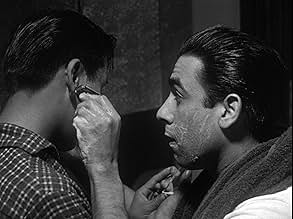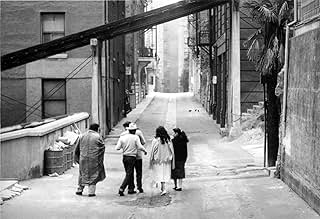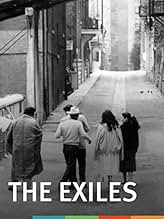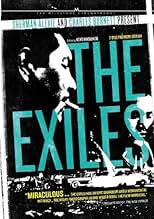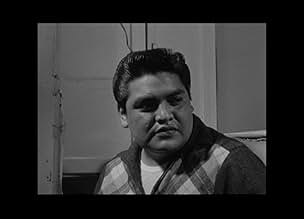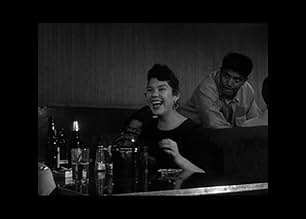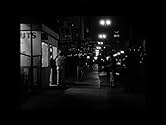NOTE IMDb
6,6/10
1,5 k
MA NOTE
Il suit une famille d'Amérindiens vivant dans la Cité des Anges.Il suit une famille d'Amérindiens vivant dans la Cité des Anges.Il suit une famille d'Amérindiens vivant dans la Cité des Anges.
- Réalisation
- Scénario
- Casting principal
- Récompenses
- 1 victoire au total
Tom Reynolds
- Tommy
- (as Tommy Reynolds)
Avis à la une
The main good points I'd like to pass on are for the benefit of those not having seen this movie.The older you are the more you may like seeing this on location film from 1961.Even for someone like me not familiar with the film location there will be things to remember,the cars,advertising,beer bottles,etc.Probably the most important point to the movie is that these Native Americans are in a new enviorment having come from the reservation,something different for that time period.The movie reflects their being between two different worlds. One of my favorite parts is when about three Indians enter a bar and greet many there warmly and one at a time. It's worth it to see the movie for the reasons previously mentioned.That being said I couldn't watch this movie without pondering questions..How much of the movie is reality? How much is drama? Is this a Friday night or every night/morning? Where does the money come from? Are they all from the same tribe? Not trying to pass off myself as a Native American expert/I speak the language but from the ones I've known it seems like at times different tribes don't get along.That's why I was wondering if the large groups in the movie were all from the same tribe.Despite the unanswered questions it's an interesting film.
10Mackzee
"The Exiles" was made on a shoe-string budget by a number of idealistic young film-makers "led" by Kent Mackenzie as "writer/director/editor.
Mackenzie and his crew were dismayed (putting it lightly)by what they saw as a lack of use of film as an artistic medium. At the same time the standard "Hollywood" aesthetic sacrificed subject, in order to obtain perfect/yet unrealistic lighting schemes, camera movement, framing and pristine sound tracks.
Erik Daarstad, John Morrill and Bob Kaufman shot an incredibly striking 35mmm B&W film. It is truly stunning. And a testament to all involved.
"The Exiles" is phenomenal in that, Mackenzie agreed not to put anything in the film that "the actors" objected to in any way. Appropriately, but very unusual, the "voice" in the film is that of the subjects.
"The Exiles" is of a specific time: a Los Angeles that literally no longer exists. And it is timeless, in the questions it asks and in it's gut wrenching portrayal of a particular group of individual's lives. Lives that unfortunately could/and do exist as I write this almost 50 years later.
Mackenzie credits the viewer with the intelligence to relate to the human condition as seen on screen. And explore for one's self how we fit into a world in which these conditions exist. We aren't forced to listen to the traditional "voice of god" voice over that dehumanizes all involved in the experience.
Sadly, Kent Mackenzie died young in May of 1980. He made relatively few films. Yet, "The Exiles" and his USC student film: "Bunker Hill" (made with Robert Kaufman) spoke to a bright young artist who worked with an integrity few possess.
If one has the opportunity to see this film as it should be, in a theater on a 35mm print. It is well worth the time. And an experience which will stay with you from that day forward.
Mackenzie and his crew were dismayed (putting it lightly)by what they saw as a lack of use of film as an artistic medium. At the same time the standard "Hollywood" aesthetic sacrificed subject, in order to obtain perfect/yet unrealistic lighting schemes, camera movement, framing and pristine sound tracks.
Erik Daarstad, John Morrill and Bob Kaufman shot an incredibly striking 35mmm B&W film. It is truly stunning. And a testament to all involved.
"The Exiles" is phenomenal in that, Mackenzie agreed not to put anything in the film that "the actors" objected to in any way. Appropriately, but very unusual, the "voice" in the film is that of the subjects.
"The Exiles" is of a specific time: a Los Angeles that literally no longer exists. And it is timeless, in the questions it asks and in it's gut wrenching portrayal of a particular group of individual's lives. Lives that unfortunately could/and do exist as I write this almost 50 years later.
Mackenzie credits the viewer with the intelligence to relate to the human condition as seen on screen. And explore for one's self how we fit into a world in which these conditions exist. We aren't forced to listen to the traditional "voice of god" voice over that dehumanizes all involved in the experience.
Sadly, Kent Mackenzie died young in May of 1980. He made relatively few films. Yet, "The Exiles" and his USC student film: "Bunker Hill" (made with Robert Kaufman) spoke to a bright young artist who worked with an integrity few possess.
If one has the opportunity to see this film as it should be, in a theater on a 35mm print. It is well worth the time. And an experience which will stay with you from that day forward.
The Exiles by Kent Mackenzie, USA (Documentary). A 1961 documentary chronicling a day in the life of a group of twenty-something Native Americans who left reservation life in the 1950s to live in LA.
A unique and powerful film, blending storytelling with documentation. Mackenzie constructed a narrative about one day in the life of three main characters - a pregnant young woman (Yvonne), the father (Homer), and a man about town (Tommy). Both men are profound alcoholics, and the woman seems stunned by the circumstances of her life though hopeful for the future of her child.
The film opens with portraits from Edward Sheriff Curtis's monumental North American Indian, which I recommend as a starting place. Mackenzie has a sharp eye for cultural details - check out the Grand Hotel mattress in Yvonne and Homer's apartment, as well as the magazines, comics, advertisements, toys, and street scenes.
The story develops via voiceovers by Yvonne, Homer, and Tommy - and an amazing middle sequence from the rez, with generous doses of native language and music.
This is a must-see movie for anyone interested in social work, indigenous peoples, or the dark side of American culture. Never boring for any viewer.
A unique and powerful film, blending storytelling with documentation. Mackenzie constructed a narrative about one day in the life of three main characters - a pregnant young woman (Yvonne), the father (Homer), and a man about town (Tommy). Both men are profound alcoholics, and the woman seems stunned by the circumstances of her life though hopeful for the future of her child.
The film opens with portraits from Edward Sheriff Curtis's monumental North American Indian, which I recommend as a starting place. Mackenzie has a sharp eye for cultural details - check out the Grand Hotel mattress in Yvonne and Homer's apartment, as well as the magazines, comics, advertisements, toys, and street scenes.
The story develops via voiceovers by Yvonne, Homer, and Tommy - and an amazing middle sequence from the rez, with generous doses of native language and music.
This is a must-see movie for anyone interested in social work, indigenous peoples, or the dark side of American culture. Never boring for any viewer.
The premise is simple-we follow a group of young, modern day Native American men and women in Los Angeles over 24 hours. We experience their daily rituals, conflicts, and pleasures, and, for the most part, I found this rather simple film to be highly interesting. Although it remains virtually plot less throughout, there are some moments of conflict and surprising intensity that save it from being "boring" or overly mundane. The tragedies as well as the comedies of life are explored, as personalities, feelings, and opinions are revealed and studied.
The highlights of the film are the dazzlingly beautiful voice over sequences, in which a random character will voice their perspective on their way of life or their friends or their hopes and aspirations, and so on. They transform the every man into a wise and lovable poet. We understand and learn about our characters more and more not only through their subtle actions, but also their words and ways of communicating.
However, there are moments of boredom here. I think this movie would have worked better as a lengthy short film that would be, say, 35-40 minutes long. That would be perfect. Either that or a little bit more conflict or humor or just flat out interesting events.
The highlights of the film are the dazzlingly beautiful voice over sequences, in which a random character will voice their perspective on their way of life or their friends or their hopes and aspirations, and so on. They transform the every man into a wise and lovable poet. We understand and learn about our characters more and more not only through their subtle actions, but also their words and ways of communicating.
However, there are moments of boredom here. I think this movie would have worked better as a lengthy short film that would be, say, 35-40 minutes long. That would be perfect. Either that or a little bit more conflict or humor or just flat out interesting events.
Astonishing slice of cinema verite at a time when young filmmakers were trying to break the Hollywood habit in favor of the real world. The 70 minutes are not entertaining; however, they do fascinate. It's a nighttime of boozing carousal for several young Indian men amid the neon jungle of downtown LA. The camera tracks their aimless wanderings and endless drinking from one seedy venue to the next. It's LA like you've seldom seen it—a down-and-outers look at unvarnished urban decay. The faces too are fascinating, not like the usual Hollywood Indian or crowd scene extras.
It's a disturbing look, slow to accumulate until the poignant final shot. These are truly lost people, caught between two incomplete worlds-- the urban jungle of the white man and the captive reservation of the Indian. The men seem to treat most everything as a joke, perhaps a way of denying the dead-end reality of their lives. Ironically, they appear now to be strangers in their own land. It's the young Indian woman Yvonne, however, who's likely to evoke audience sympathy. It's she who dreams (her inner thoughts vocalized in voice-over) of a family and something like a normal life. But, the men in her life are truly lost, so her hopes appear doomed as well. Seeing this document may help viewers better understand the controversial American Indian Movement (AIM) of the 1970's.
Apparently, the project spanned several years of interrupted funding. Thus, the film has to be an artistic commitment of a high order on the part of filmmaker MacKenzie. Did he hope for a commercial release. A story and technique like this would seem to hold little promise of that. Did he hope for art house distribution and an appeal to the intelligentsia. Whatever the motivation, he's produced a document of lasting social value, and thanks be to TMC for bringing MacKenzie's achievement to today's audiences
It's a disturbing look, slow to accumulate until the poignant final shot. These are truly lost people, caught between two incomplete worlds-- the urban jungle of the white man and the captive reservation of the Indian. The men seem to treat most everything as a joke, perhaps a way of denying the dead-end reality of their lives. Ironically, they appear now to be strangers in their own land. It's the young Indian woman Yvonne, however, who's likely to evoke audience sympathy. It's she who dreams (her inner thoughts vocalized in voice-over) of a family and something like a normal life. But, the men in her life are truly lost, so her hopes appear doomed as well. Seeing this document may help viewers better understand the controversial American Indian Movement (AIM) of the 1970's.
Apparently, the project spanned several years of interrupted funding. Thus, the film has to be an artistic commitment of a high order on the part of filmmaker MacKenzie. Did he hope for a commercial release. A story and technique like this would seem to hold little promise of that. Did he hope for art house distribution and an appeal to the intelligentsia. Whatever the motivation, he's produced a document of lasting social value, and thanks be to TMC for bringing MacKenzie's achievement to today's audiences
Le saviez-vous
- AnecdotesKent Mackenzie borrowed equipment from industrial film makers Parthenon Pictures and used the unused "ends" of thousand-foot reels of 35mm film, according to an article in the 12 March 1961 edition of the New York Times.
- GaffesIn a scene where an older man is heard singing and playing an instrument under a tree, he is not doing corresponding actions in a long-shot.
- ConnexionsFeatured in Los Angeles Plays Itself (2003)
Meilleurs choix
Connectez-vous pour évaluer et suivre la liste de favoris afin de recevoir des recommandations personnalisées
- How long is The Exiles?Alimenté par Alexa
Détails
Box-office
- Budget
- 539 $US (estimé)
- Montant brut aux États-Unis et au Canada
- 30 945 $US
- Week-end de sortie aux États-Unis et au Canada
- 8 448 $US
- 13 juil. 2008
- Montant brut mondial
- 30 945 $US
- Durée1 heure 12 minutes
- Couleur
- Mixage
- Rapport de forme
- 1.37 : 1
Contribuer à cette page
Suggérer une modification ou ajouter du contenu manquant

Lacune principale
By what name was The Exiles (1961) officially released in India in English?
Répondre

